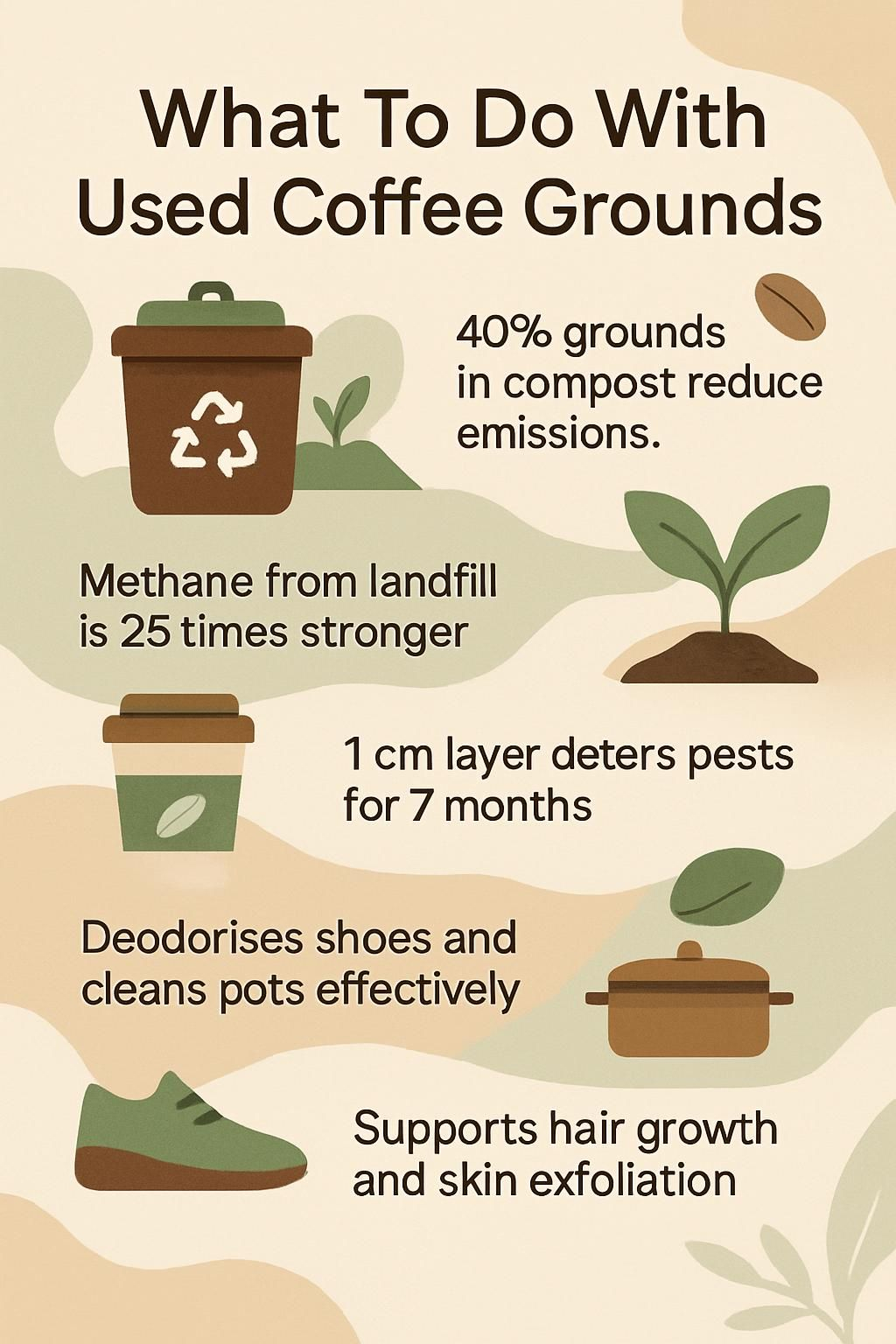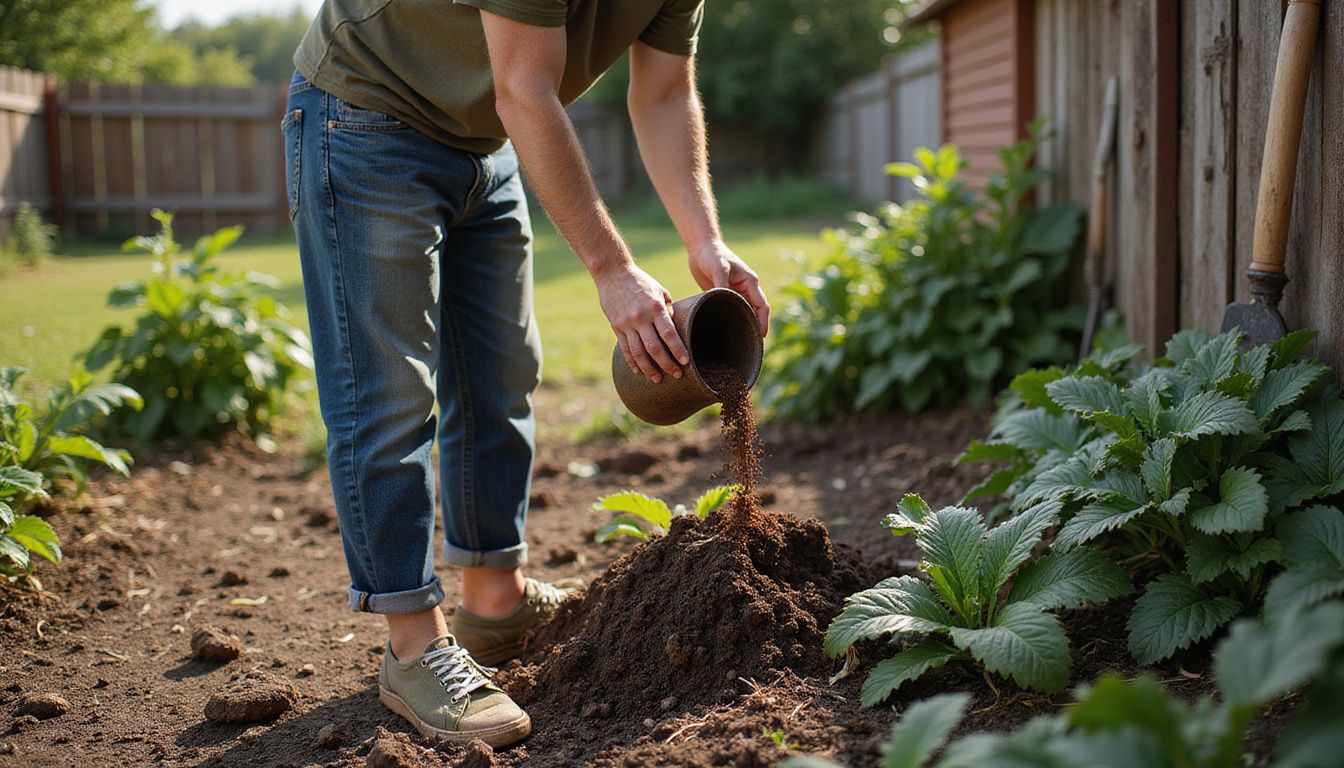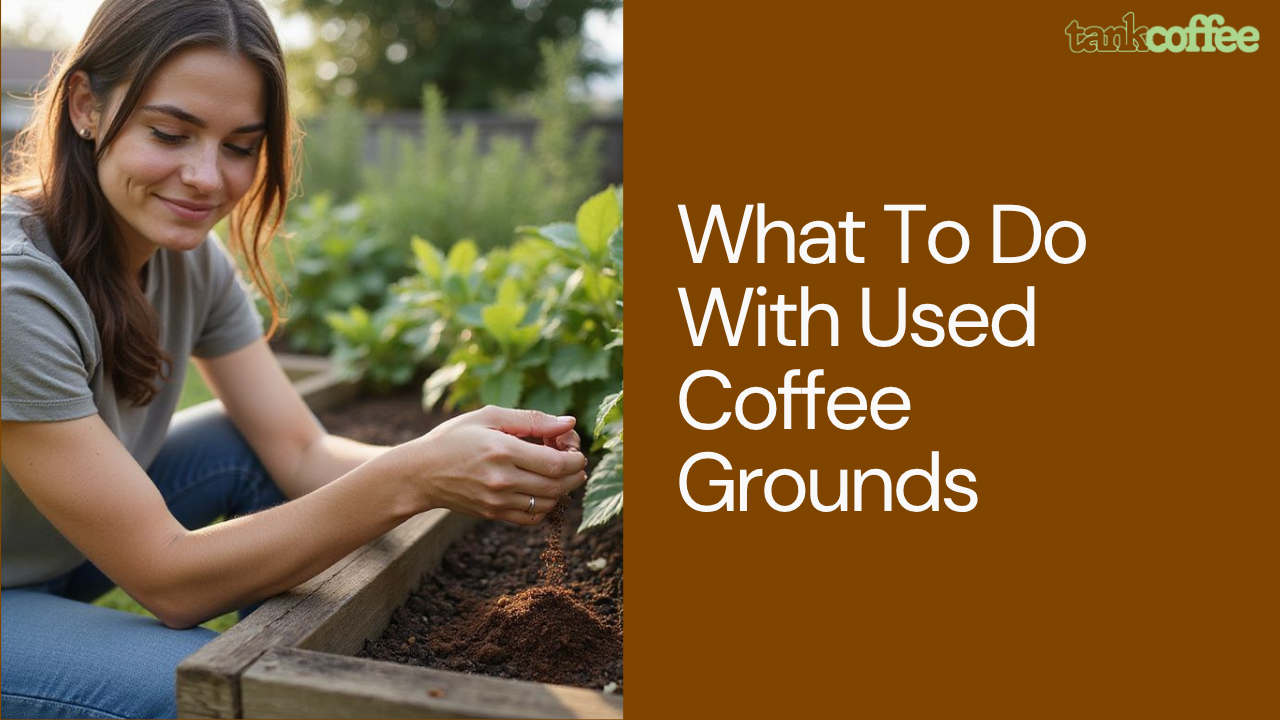What To Do With Used Coffee Grounds
After your morning brew, don’t let the best part of your coffee go to waste. Those used coffee grounds are packed with valuable nutrients like nitrogen, phosphorus, and potassium.
In my decade leading a major UK online coffee company, I’ve seen the incredible potential in what most people throw away. Discarding grounds contributes to landfill methane, a greenhouse gas far more potent than carbon dioxide.
A 2016 study from Santos C et al. confirmed that composting them can slash these emissions and create richer soil. From skincare to slug control, the value is undeniable.
This guide will show you exactly how to reuse coffee grounds, turning everyday kitchen waste into a powerful resource for your home and garden.
Key Takeaways
- Used coffee grounds are rich in nitrogen, potassium, and phosphorus, making them useful as a fertiliser or in compost piles. A 2016 study showed adding up to 40% grounds to compost reduces greenhouse gas emissions and improves soil humus.
- Throwing coffee grounds in landfill creates methane, a potent greenhouse gas. Reusing them at home cuts this harmful waste and supports environmental protection.
- Spent coffee grounds help deter slugs and snails in gardens. A 2023 study found that a 1 cm layer of grounds kept these pests away from pots for up to seven months.
- Coffee grounds can remove odours in your home and act as an abrasive scrub for cleaning. Research from 2021 and 2023 has confirmed their deodorising and antibacterial properties.
- You can use coffee grounds as a natural dye for fabrics, fix scratches on dark wood furniture, and support skin exfoliation and hair growth routines.

Why Shouldn’t You Throw Away Used Coffee Grounds?
You should avoid throwing away used coffee grounds because they release methane in landfill, a greenhouse gas over 25 times more potent than carbon dioxide. The UK consumes around 98 million cups of coffee daily, creating a huge amount of organic kitchen waste that harms the environment.
But this waste is actually a resource. Used grounds are rich in nutrients like nitrogen (about 2% by volume), potassium, and phosphorus. These are vital for plant growth. Some innovative food companies even add spent grounds to meat packaging, as their antioxidant properties help keep products fresh for longer.
Pioneering UK companies are already showing the industrial-scale value of this waste. London-based company bio-bean, for example, recycles spent coffee grounds into biofuels and solid fuels like their ‘Coffee Logs’, which can be used in wood-burning stoves. By reusing your grounds at home, you adopt the same sustainable mindset, reducing your carbon footprint and turning waste into value.
How Can You Use Coffee Grounds for Sustainable Gardening?
You can use coffee grounds in your garden to create healthier soil and nourish your plants. These grounds are a fantastic natural material that can boost plant growth, deter common pests like slugs and snails, and improve the overall structure of your garden soil.
Composting Coffee Grounds
Adding used coffee grounds is an excellent way to supercharge your compost pile. They provide a valuable source of nitrogen, which is essential for healthy soil.
- Treat used coffee grounds as a “green” material in your compost bin, thanks to their high nitrogen content.
- Mix them with other kitchen scraps like fruit peels and vegetable trimmings, but always avoid meat, dairy, or oily foods.
- Balance the green materials by adding “brown” materials like dried leaves, straw, or cardboard. The ideal compost carbon-to-nitrogen ratio is about 30:1, and since coffee grounds are about 20:1, they need plenty of carbon-rich browns to balance them.
- Incorporate up to 40 per cent coffee grounds by volume. The 2016 study showed this specific level reduces greenhouse gas emissions and produces high-quality humus.
- Break apart any clumps of coffee grounds before adding them to the pile. This simple step ensures air and water can circulate, preventing mouldy patches.
- Coffee grounds can also help absorb heavy metals from the soil, making your finished compost safer for growing vegetables.
- Turn your compost heap every week or two. This aerates the pile, helping microbes break everything down faster.
- Maintain a consistent moisture level, similar to a wrung-out sponge. If the pile is too wet it will smell, and if it’s too dry the decomposition will stall.
- Your compost should be ready in two to three months. You’ll know it’s done when it’s dark, crumbly, and has an earthy smell.
- Use the finished compost as a mulch around your plants or mix it into your garden beds to enrich the soil.
- Many local coffee shops, including chains like Starbucks with its “Grounds for Your Garden” scheme, offer free spent coffee grounds. Just ask your local barista.
Using Coffee Grounds As Fertiliser
Used coffee grounds make a fantastic natural fertiliser because they are rich in key plant nutrients like nitrogen, phosphorus, and potassium. Applying them correctly can lead to stronger, healthier plants.
While fresh coffee grounds are acidic, used grounds are nearly pH neutral (6.5 to 6.8), making them safe for most plants. They are especially beneficial for acid-loving plants.
- Roses
- Hydrangeas
- Blueberries
- Azaleas and Rhododendrons
Sprinkle the grounds thinly on the soil around your plants. To avoid clumping, which can block water, it’s best to mix them with other organic matter like leaf mould or finished compost before applying. Aim for a layer no more than half an inch thick.
A 2020 study demonstrated that using coffee grounds as a fertiliser improved the nutritional content of vegetables, including lettuces and carrots. This shows it doesn’t just help plants grow, it can make them better for you too.
Avoid using them on plants that prefer alkaline soils, such as lavender and honeysuckle, as even a slight change in pH can affect their growth. Many baristas in local coffeehouses will happily give you bags of used grounds for free, providing an economical way to nourish your garden.
Repelling Pests Naturally
Used coffee grounds can serve as an effective and natural repellent for many common garden pests. Their abrasive texture and strong aroma create a barrier that many insects and molluscs dislike crossing.
You can create a protective circle around your plants by sprinkling a line of grounds 1 to 2 inches wide. This is particularly effective against:
- Slugs and snails: They find the texture difficult to move across.
- Ants: The smell can disrupt their scent trails, making it harder for them to navigate.
- Mosquitoes: The scent of burning coffee grounds is a known mosquito repellent.
A 2023 study confirmed that a 1 cm layer of used grounds in plant pots successfully deterred slugs and snails for up to seven months, though the effect diminishes as the grounds age. For flea control, you can rub a small amount of grounds into your pet’s coat after shampooing, but be careful not to let your pet ingest any.

What Are Some Household Hacks With Coffee Grounds?
You can use spent coffee grounds around your home to tackle common problems. They are great for neutralising stubborn smells and for scrubbing tough messes in the kitchen, offering a sustainable alternative to chemical products.
Neutralising Odours Around Your Home
Coffee grounds are excellent at absorbing and neutralising bad smells because of their porous nature and nitrogen content. A 2021 study by Kim M-S confirmed their ability to capture and eliminate unpleasant odours.
To make it work, you first need to dry the grounds completely. Spread them on a baking tray and bake at a low temperature until they are no longer damp. This prevents mould.
Once dry, you can:
- Place a bowl of grounds in your fridge or freezer to combat food odours. They should be replaced every few weeks.
- Fill small breathable bags, like old socks or muslin pouches, with grounds and place them in smelly shoes, gym bags, or wardrobes.
- Sprinkle a small amount at the bottom of your kitchen bin to help control rubbish smells between changes.
Cleaning And Scrubbing Pots And Pans
The abrasive texture of used coffee grounds makes them a powerful, natural scouring agent. You can use them to scrub away burnt-on food and grease from your cookware without using harsh chemicals.
Simply sprinkle a handful of grounds directly onto your pots and pans and scrub with a sponge or brush. A 2023 study by Gimenez-Martinez P et al. highlighted that coffee grounds also possess antibacterial and antiviral properties, adding a cleaning boost.
| Safe To Use On | Materials to Avoid |
|---|---|
| Stainless Steel | Non-stick or Teflon |
| Cast Iron | Ceramic |
| Aluminium | Enamelled Cookware |
Using grounds on porous or easily scratched surfaces can cause staining or damage. Always rinse your cookware thoroughly after scrubbing to remove any coffee residue and prevent any lingering aroma.
How Can You Use Coffee Grounds for DIY Beauty?
You can easily incorporate used coffee grounds into your beauty routine at home. Their texture and caffeine content make them ideal for creating simple, effective treatments for your skin and hair.
Exfoliating Skin With Coffee Scrubs
Used coffee grounds are a fantastic natural exfoliant. Their gritty texture is perfect for removing dead skin cells and dirt, leaving your skin feeling smoother and looking brighter.
- Create a simple body scrub by mixing a handful of used coffee grounds with a natural oil like coconut or olive oil, or even honey, to form a thick paste.
- In the shower, apply the mixture to your body in gentle, circular motions. This helps to scrub away dead cells and stimulate blood flow.
- Focus on areas that can be rough, like elbows, knees, and feet.
- The caffeine in the grounds may also help temporarily reduce the appearance of cellulite. A 2023 study by Gabriel A et al. found that caffeine can help break down fat cells and increase circulation.
- For targeted cellulite treatment, let the paste sit on the area for about 10 minutes before rinsing thoroughly with warm water.
- While great for the body, the grounds can be too abrasive for the delicate skin on your face. It’s best to stick to body application.
- Always do a patch test on a small area of skin first to ensure you don’t have a reaction.
Many commercial scrubs, like those from Frank Body, use coffee as a key ingredient, but making your own at home is a simple, zero-waste alternative.
Stimulating Hair Growth Naturally
The caffeine in coffee grounds can be beneficial for your hair and scalp. When applied topically, it can help stimulate blood flow to the follicles, which may support healthy hair growth.
Here’s a simple routine to try once or twice a week.
- Before you shampoo, take one to two tablespoons of used coffee grounds and gently massage them into your scalp for a few minutes.
- The abrasive texture helps to exfoliate the scalp, removing product build-up and dead skin cells that can clog follicles.
- This process can also help reduce dandruff and may make your hair appear shinier and feel softer.
- Some research suggests caffeine can help counter the effects of DHT, a hormone linked to hair loss, when applied directly to the hair roots.
- Rinse the grounds from your hair thoroughly with water before continuing with your normal shampoo and conditioning routine.
Be aware that grounds can be difficult to rinse out completely, especially from thick or very long hair. Mixing them with your regular conditioner can sometimes make the process easier.
What Are Some Creative Uses for Coffee Grounds?
Beyond the garden and bathroom, used coffee grounds have several clever and practical applications around the house. You can use them for creative craft projects or for quick fixes on everyday items.
Repairing Scratches On Wooden Furniture
You can use the natural dyeing properties of coffee grounds to conceal minor scratches on dark wooden furniture. The tannins in coffee act as a natural stain, helping to blend scuffs with the wood’s original finish.
- Make a thick paste by mixing a few teaspoons of used coffee grounds with a small amount of water or olive oil.
- Use a cotton swab to apply the paste directly into the scratch, making sure to cover it completely.
- Let the paste sit for about 10 minutes to allow the colour to absorb into the wood.
- Gently wipe away the excess grounds with a soft, dry cloth.
- You can repeat the process if the scratch needs to be darker to match the surrounding wood.
This method works best on dark woods like mahogany, walnut, or dark-stained oak. It’s a quick, inexpensive fix that avoids the harsh chemicals found in many commercial repair kits.
Creating Natural Dyes For Fabrics Or Paper
Used coffee grounds can be repurposed to create a beautiful, natural brown dye for fabrics and paper. It’s a simple process that gives materials a vintage, earth-toned look.
To create a dye bath, you’ll need to rewet your coffee grounds. A good starting ratio is about one cup of grounds for every two litres of water. Simmer the mixture for at least an hour to extract the colour, then strain out the grounds.
The dye works best on natural fibres.
- Cotton and Linen: These fabrics absorb the colour very well, resulting in deep, rich tones.
- Rayon and Cellophane: Also take the dye well.
- Paper: Can be dipped or painted with the dye for an aged, parchment effect.
For the colour to last and resist fading, you’ll need to use a mordant, which helps the dye fix to the fabric. You can buy these from craft suppliers like Hobbycraft. Iron works well for cotton, while alum is better for silk. Adding a mordant will result in a much more durable and vibrant colour.
How Reusing Grounds Helps the Environment
Coffee production has a significant environmental footprint, and waste is a major part of that. When you throw used coffee grounds into your general waste bin, they end up in a landfill. There, they decompose without oxygen and release methane, a greenhouse gas with over 25 times the warming power of carbon dioxide.
Globally, millions of tonnes of spent grounds are generated by the coffee industry each year.
Reusing coffee grounds at home directly reduces this impact. Every time you add them to your compost, use them as fertiliser, or repurpose them for cleaning, you are diverting waste from landfill. This action helps lower methane emissions. Using grounds in your garden also recycles valuable nutrients back into the ecosystem, reducing the need for chemical fertilisers. On a larger scale, some companies are now using spent coffee to create bioenergy, turning a common waste product into a source of clean fuel.
Start Using Your Coffee Grounds Today
Used coffee grounds are far more than simple kitchen waste. You can apply them in over 11 practical ways to improve your garden, simplify your cleaning, and enhance your personal care routines.
Whether you use coffee grounds as a nitrogen-rich fertiliser for plants like roses or to keep slugs away from your vegetables, the benefits are clear.
Inside, they can tackle strong odours or serve as a base for a natural body scrub. You can even use old grounds to create natural dyes for fabrics or to repair scratches on wooden furniture.
By putting these simple ideas to work, you can save money, reduce landfill waste, and create a healthier, more sustainable home.
FAQs
1. How can I use coffee grounds as fertiliser for my garden?
Used coffee grounds are a fantastic natural fertiliser because they add nitrogen to the soil, which is especially beneficial for acid-loving plants like hydrangeas and roses. They can also be used as a substrate for growing certain types of mushrooms, such as oyster mushrooms.
2. Can coffee grounds help deter pests in my garden?
Yes, the abrasive texture and caffeine content in coffee grounds create a barrier that can effectively deter slugs and snails.
3. Are there creative uses for coffee grounds in the home?
You can use dried coffee grounds to remove odours from your refrigerator or freezer by placing them in an open bowl to absorb strong smells. The nitrogen in the coffee helps to neutralise foul odours.
4. How do coffee grounds help with exfoliation and hair care?
To create a simple and effective body scrub, you can mix used coffee grounds with a carrier oil like coconut oil to form a paste that removes dead skin. For hair care, massaging the grounds into your scalp can help exfoliate the skin and stimulate blood flow.
5. Can I use coffee grounds for dyeing or as a cleaning agent?
Yes, you can use coffee grounds to create a natural brown dye for fabrics like cotton or for ageing paper. The grounds’ slightly abrasive texture also makes them a useful cleaning agent for scrubbing stubborn food residue from pots and pans.
6. What are other practical uses for used coffee grounds?
The natural acids and enzymes in coffee grounds act as a great tenderiser for meat. Additionally, they are an excellent ‘green’ material for your compost pile, balancing the carbon-rich ‘brown’ materials and enriching the final humus.

